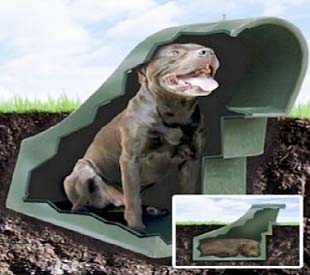Underground Dog Houses
Just like some humans prefer living underground to above ground
because of the benefits of doing so, it is also becoming popular
to put one's pooch underground as well (even if you don't live
a subterranean lifestyle).
 Underground Dog House
Underground Dog House |
At first glance this may seem a little
absurd, but there are some real benefits in doing so.
|
Advantages of Underground Dog Houses
An underground dog house is a viable solution to preventing your
dog from the sizzling heat and freezing winters. In summers, a
properly ventilated underground dog house will stay cool and your
dog will simply love staying inside.
In winters, a properly insulated underground den will keep your
pet warm inside rather than come out in shivering cold. An offset
door is more likely to provide windbreak for your beloved dog.
Using blue foam insulation everywhere along with pegboard on the
interior walls will certainly provide the best protection for
your canine from the freezing temperatures.
Disadvantages of Underground Dog Houses
However, there are some disadvantages of underground dog houses,
some of which are as follows:
- Without proper ventilation, underground dog houses can make
it hard for the animal to breathe.
- Without proper construction, cleaning the underground dog
house can be challenging.
Building Underground Dog Houses
Your underground dog den can be dug three to four feet below.
Cover the dug surface with pea gravel for groundwater and then
build concrete footing on it so that it is leveled and stays intact.
Use concrete blocks for the walls and a wooden structure for the
roof.
Use metallic or plastic flaps for pet doorways so that your dog
can easily push against with his head or paw to enter the den
or come out. Keep ventilation vents at key places in the walls
having removable panels. The vents provide the cooling effect
in summer.
Keep the walls insulated in winters using foam. Fleas and ticks
could be a big headache for you. But to deter fleas and ticks,
line the bed with wood chips. Don't use any blanket, carpet, towel,
fabric, or even straw as bed, which can easily attract fleas or
ticks, especially where there is darkness, moisture, and body
heat. You can use cedar shavings as bedding. Even a moisture-proof
dense foam pad is a better alternative.
Fido, Below!
So, just like with humans living partly underground for a dog
the same will provide it with the benefits of staying cooler in
summer and warmer in winter than a traditional dog house. And
chances are your pooch will take pride in their private and proprietary
dwelling that you have built or bought just for them.
|

